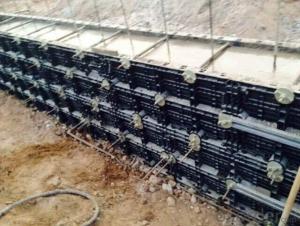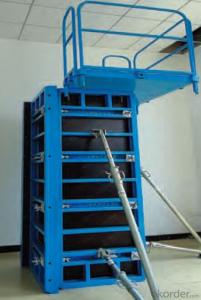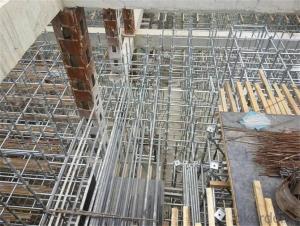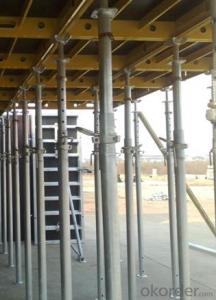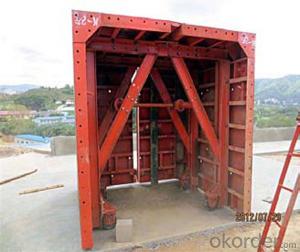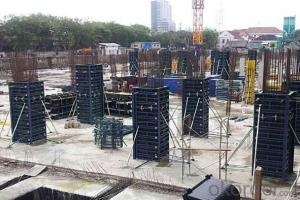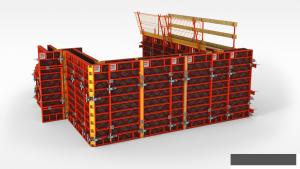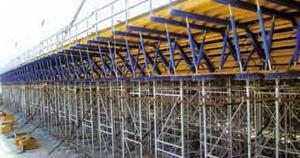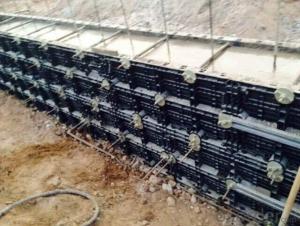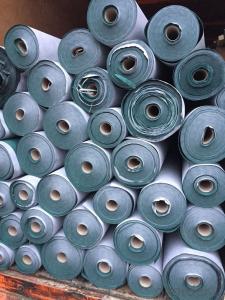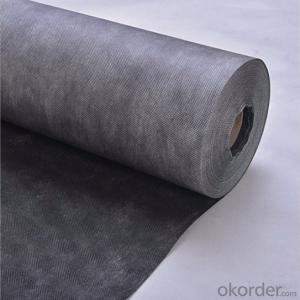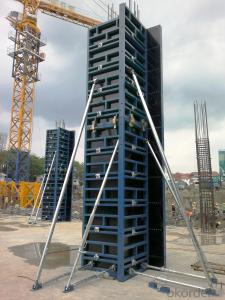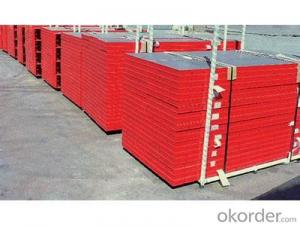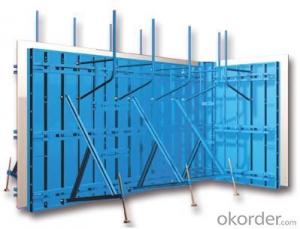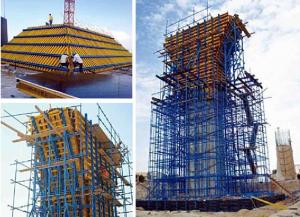new plastic formworks used in construction industry
- Loading Port:
- Shanghai
- Payment Terms:
- TT OR LC
- Min Order Qty:
- 1 m²
- Supply Capability:
- 100000 m²/month
OKorder Service Pledge
OKorder Financial Service
You Might Also Like
1. Main Introduction of Plastic Formwork:
Hot rolled deformed steel framework. the peripheral board is made of FRTP plastic template and add some steel ribssupporting the panel welding a new type of industrialization combined template.which is mainl. The biggest panel is 120x60cm, weight only 10.5kg, which can be lift and set up by only one person easily, need no crane on the site.
2. The Advantages of Plastic Formwork:
-easy set up
Different size of panels can be firmly locked by simply turn the special handles to 90 degree. The panels have rib on the back, which makes the
system need not traditional wood blocks and nails. The panels have holes to fit tie rod, guarantee the strength of the whole system.
-modularity
Modular formwork composed by different size of panels, the main item is 120x60 panel, the size is 120x60cm, which used for the large area of walls
and slabs. There are also small size of panels like 10x60 panel (10x60cm), 20x60 panel (20x60cm), 25x60 panel (25x60cm), inner corner (20x20x60cm) and outer corner (10x5x60cm). Due to the variety of panel size, the system can form almost all size walls120x60 panel (act size 120x60cm) of multiple by 5cm. The material of modular formwork is PC-ABS mixied with special glass fibres which enable panels to hold high pressures.
-strength
The handles are made by high strength Nilon, each panel locked by at least 4 handls, which makes the whole system strong enough to pour 40cm walls.
-enviroment friendly
The system need not cut and nail due to the variety size, and nearly need no wood, the material can be recycled after broken, will not pollute the enviroment.
-consequent
Concrete does not stick to plastic, thus the panels need no oil before using, and can be cleaned simply by water. The surface of the wall which built by modular formwork is smooth, can be left without rework.
3. Images for Plastic Formwork:
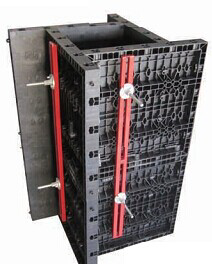
4. FAQ of Plastic Formwork
1) What can we do for you?
We can ensure the quality of the vinyl banner and avoid extra expenses for customers.
.We can provide you the professional design team.
.We can provide fashionable and newest styles for you.
.We can design the artwork for you.
. Please feel free to customize.
2) What promises can be done by us?
. If interested in plastic formwork, please feel free to write us for any QUOTE.
. If printing required, please advise asap because the whole set need much more time to complete.
. Please DO check goods when courier knocks your door and contact us asap if any issue.
- Q:Can steel frame formwork be used for precast wall panels?
- Precast wall panels can indeed utilize steel frame formwork. Construction projects often employ steel frame formwork for various purposes, one of which is the creation of precast wall panels. This method involves the use of steel formwork, which provides a robust and long-lasting structure for casting the concrete panels. The steel formwork possesses the ability to withstand the immense pressure exerted by the wet concrete during the curing process. Furthermore, this type of formwork enables the precise and meticulous shaping of the wall panels, ensuring they meet the desired specifications and dimensions. The steel frame formwork system can be effortlessly assembled and disassembled, which proves highly convenient for repetitive use in the mass production of precast wall panels. Ultimately, the employment of steel frame formwork for precast wall panels offers a multitude of advantages, including strength, durability, accuracy, and ease of use.
- Q:How does steel frame formwork address issues of concrete shrinkage and expansion?
- Steel frame formwork is a construction technique that effectively addresses the issues of concrete shrinkage and expansion. Firstly, steel is known for its high tensile strength, which means it can withstand the forces exerted by concrete during the shrinkage and expansion process. This prevents any cracking or damage to the concrete structure. Additionally, steel frame formwork provides a rigid and stable framework for pouring concrete. This ensures that the concrete is evenly distributed and properly supported, minimizing the risk of uneven shrinkage or expansion. The steel frame also acts as a barrier, preventing the concrete from expanding beyond its intended dimensions. Moreover, steel frame formwork allows for the use of expansion joints. These joints are strategically placed in the formwork to accommodate the natural movements of the concrete caused by temperature changes and moisture variations. By incorporating these expansion joints, the steel frame formwork allows the concrete to shrink and expand without causing any structural issues or damage. Furthermore, steel frame formwork can be easily adjusted and modified to accommodate changes in concrete dimensions due to shrinkage or expansion. This flexibility allows for the necessary adjustments to be made during the construction process, ensuring a precise and accurate final product. In conclusion, steel frame formwork addresses the issues of concrete shrinkage and expansion by providing a strong and stable framework, incorporating expansion joints, and allowing for easy adjustments. This construction technique ensures that the concrete structure remains intact and free from any damage caused by these natural processes.
- Q:What are the different methods of bracing steel frame formwork?
- There are several methods of bracing steel frame formwork, including diagonal bracing, cross bracing, and horizontal bracing. Diagonal bracing involves installing diagonal members between vertical and horizontal members to provide stability and prevent lateral movement. Cross bracing involves installing diagonal members in an X pattern between vertical members to provide additional stability. Horizontal bracing involves installing horizontal members between vertical members to resist lateral forces and maintain the formwork in position. These bracing methods are essential in ensuring the structural integrity and safety of the steel frame formwork during construction.
- Q:What are the key considerations for selecting the appropriate steel frame formwork system for projects with limited construction budgets?
- When selecting an appropriate steel frame formwork system for projects with limited construction budgets, there are several key considerations that need to be taken into account. These considerations include: 1. Cost-effectiveness: The primary concern for projects with limited construction budgets is to ensure that the chosen steel frame formwork system is cost-effective. This means selecting a system that provides the necessary functionality and durability at an affordable price. It is important to compare different options and consider both the upfront cost and the long-term maintenance costs. 2. Flexibility and reusability: Another important consideration is the flexibility and reusability of the steel frame formwork system. Projects with limited budgets often require the formwork system to be used for multiple concrete pours or across different projects. Therefore, selecting a system that can be easily adapted and reused saves both time and money in the long run. 3. Durability and quality: While cost-effectiveness is crucial, it is equally important to ensure that the steel frame formwork system is durable and of high quality. Low-quality formwork systems may result in additional costs due to frequent repairs or replacements. Therefore, it is important to select a system that is built to withstand the demands of the project and will not compromise safety or structural integrity. 4. Ease of assembly and disassembly: Projects with limited budgets often require efficient construction processes to save time and labor costs. Therefore, selecting a steel frame formwork system that is easy to assemble and disassemble is essential. This will not only enable faster construction but also reduce the need for specialized labor, ultimately saving money. 5. Availability and accessibility: It is important to consider the availability and accessibility of the chosen steel frame formwork system. Projects with limited budgets may benefit from selecting a system that is readily available in the local market or can be easily sourced. This will help avoid delays and additional costs associated with importing or acquiring specialized equipment. In conclusion, when selecting an appropriate steel frame formwork system for projects with limited construction budgets, cost-effectiveness, flexibility, durability, ease of assembly, and availability are key considerations. By carefully evaluating these factors, project managers can make informed decisions that optimize the use of resources and ensure successful project outcomes within the budget constraints.
- Q:How does steel frame formwork accommodate for different concrete mix designs?
- Steel frame formwork is a versatile solution that can easily accommodate different concrete mix designs. The steel frames are designed in a way that allows for adjustments and modifications to meet the specific requirements of each concrete mix. Firstly, the steel formwork can be adjusted to accommodate for different concrete mix designs by altering the size and shape of the formwork panels. This can be done by adding or removing sections of the steel frames or by using adjustable panels that can be resized accordingly. These modifications ensure that the formwork is compatible with the dimensions and specifications of the concrete mix. Additionally, steel frame formwork is flexible in terms of the surface finish required for different concrete mix designs. The formwork can be modified to incorporate various surface treatments such as smooth finishes, textured finishes, or patterned finishes. This flexibility allows for different concrete mix designs to achieve the desired aesthetic and functional requirements. Moreover, steel frame formwork can also accommodate for different concrete mix designs by incorporating specific features or reinforcements. For example, if a concrete mix requires additional support or reinforcement, the steel frames can be modified to incorporate additional beams, braces, or tie rods. These reinforcements ensure the structural integrity and stability of the formwork, enabling it to withstand the pressures and forces exerted by different concrete mix designs. In summary, steel frame formwork is a highly adaptable solution that can easily accommodate for different concrete mix designs. The adjustability of the formwork panels, flexibility in surface finish, and the ability to incorporate specific features or reinforcements ensure that the formwork is compatible with various concrete mix designs and can meet the specific requirements of each project.
- Q:What is the average lifespan of a steel frame formwork system?
- The average lifespan of a steel frame formwork system can vary depending on various factors such as the quality of materials, maintenance, and frequency of use. However, with proper care and maintenance, a well-built steel frame formwork system can last anywhere from 10 to 20 years or even more.
- Q:What are the common maintenance and repair procedures for steel frame formwork systems?
- Steel frame formwork systems typically require regular inspections and maintenance tasks to ensure their durability and functionality. The following are some common procedures: 1. Regular Cleaning: It is important to clean the steel frame formwork system after each use to remove concrete residues, dirt, or debris. This can be accomplished by using water, brushes, or pressure washers. Regular cleaning helps prevent the accumulation of corrosive substances and ensures the formwork remains in good condition. 2. Rust Removal: Steel frames are prone to rust, especially when exposed to moisture or corrosive materials. Perform regular inspections of the formwork for any signs of rust or corrosion. If rust is detected, it should be eliminated using appropriate techniques such as sanding, wire brushing, or chemical rust removers. After removing the rust, apply anti-rust coatings to the affected areas to prevent future corrosion. 3. Alignment and Straightening: Over time, steel frame formwork systems may become misaligned or bent due to heavy loads or improper handling. Regularly check the alignment of the frames and ensure they are straight and level. If any misalignment or bending is observed, realign or straighten the frames using suitable tools and techniques. This is crucial to maintain the accuracy and stability of the formwork system. 4. Welding Repairs: If cracks or damages are found in the steel frames, welding repairs may be necessary. Trained professionals should perform welding using appropriate techniques and equipment. This ensures the structural integrity of the formwork system and prevents further damage. 5. Lubrication: Some steel frame formwork systems have moving parts, such as hinges or adjustable components. Regularly lubricate these parts with suitable lubricants to prevent friction and ensure smooth operation. Lubrication also helps protect the system from rust and corrosion. 6. Inspection of Accessories: Alongside the steel frames, it is important to inspect and maintain the accessories and components of the formwork system, such as nuts, bolts, pins, and clamps. Regularly check these items for any signs of wear, damage, or corrosion. Promptly replace any damaged or worn-out accessories. 7. Storage and Handling: Proper storage and handling of the steel frame formwork system are crucial for its longevity. Store the formwork in a dry and well-ventilated area to prevent moisture accumulation. Avoid excessive stacking, as this can cause deformation or damage. When handling the formwork, use appropriate lifting equipment and techniques to prevent accidents and minimize stress on the frames. By adhering to these common maintenance and repair procedures, steel frame formwork systems can be maintained in optimal condition, ensuring their longevity and reliability in construction projects.
- Q:How does steel frame formwork ensure a smooth concrete finish?
- Steel frame formwork ensures a smooth concrete finish by providing a rigid structure that holds the concrete in place during the pouring and curing process. The steel frame is designed to be dimensionally stable and resistant to warping, ensuring that the formwork maintains its shape and prevents any deformation or movement of the concrete. This stability allows for consistent and even distribution of the concrete, resulting in a smooth and uniform surface finish. Additionally, steel formwork can be customized with various surface treatments, such as coatings or linings, to further enhance the smoothness of the concrete finish.
- Q:What are the different types of formwork bracing used in steel frame formwork systems?
- There are several types of formwork bracing used in steel frame formwork systems, each serving a specific purpose in providing stability and support to the formwork structure. 1. Vertical Bracing: This type of bracing is used to provide vertical support to the formwork system. It helps to resist the vertical loads and prevent any deformation or collapse of the formwork. Vertical braces are typically placed at regular intervals along the height of the formwork, ensuring stability and preventing any sagging or bulging. 2. Horizontal Bracing: Horizontal bracing is used to provide lateral support to the formwork system. It helps to resist the horizontal forces, such as wind or concrete pressure, and prevents any lateral movement or buckling of the formwork. Horizontal braces are typically placed at regular intervals along the width of the formwork, ensuring overall stability and preventing any distortion. 3. Diagonal Bracing: Diagonal bracing is used to provide both vertical and lateral support to the formwork system. It helps to resist the combined forces of vertical and horizontal loads, ensuring stability and preventing any deformation or collapse of the formwork. Diagonal braces are typically installed in a diagonal pattern, connecting the vertical and horizontal bracing elements, creating a triangulated structure that enhances the overall strength and rigidity of the formwork. 4. Kicker Bracing: Kicker bracing is used to provide additional support and stability to the formwork system, especially at the corners or edges where there may be higher stresses or bending moments. Kickers are typically placed diagonally from the bottom of the formwork to the ground or a solid anchor point, providing extra resistance against any movement or displacement. 5. Tie Rods and Anchor Bracing: Tie rods and anchor bracing are used to secure the formwork system to the surrounding structure, such as columns or walls. They help to transfer the forces and loads from the formwork to the supporting structure, ensuring stability and preventing any detachment or failure of the formwork. Tie rods are typically embedded within the concrete and connected to the formwork, while anchor bracing is attached to the adjacent structure, creating a strong and secure connection. Overall, the combination of these different types of formwork bracing ensures the stability, integrity, and safety of the steel frame formwork system, allowing for efficient construction processes and successful concrete pouring.
- Q:What are the different types of joints used in steel frame formwork?
- The different types of joints used in steel frame formwork include butt joints, lap joints, tongue and groove joints, and corner joints.
1. Manufacturer Overview |
|
|---|---|
| Location | |
| Year Established | |
| Annual Output Value | |
| Main Markets | |
| Company Certifications | |
2. Manufacturer Certificates |
|
|---|---|
| a) Certification Name | |
| Range | |
| Reference | |
| Validity Period | |
3. Manufacturer Capability |
|
|---|---|
| a)Trade Capacity | |
| Nearest Port | |
| Export Percentage | |
| No.of Employees in Trade Department | |
| Language Spoken: | |
| b)Factory Information | |
| Factory Size: | |
| No. of Production Lines | |
| Contract Manufacturing | |
| Product Price Range | |
Send your message to us
new plastic formworks used in construction industry
- Loading Port:
- Shanghai
- Payment Terms:
- TT OR LC
- Min Order Qty:
- 1 m²
- Supply Capability:
- 100000 m²/month
OKorder Service Pledge
OKorder Financial Service
Similar products
New products
Hot products
Hot Searches

